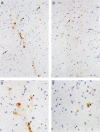Serotonin 5-HT2A and 5-HT6 receptors in the prefrontal cortex of Alzheimer and normal aging patients
- PMID: 16640790
- PMCID: PMC1523198
- DOI: 10.1186/1471-2202-7-36
Serotonin 5-HT2A and 5-HT6 receptors in the prefrontal cortex of Alzheimer and normal aging patients
Abstract
Background: It has been hypothesized that alterations of the serotonergic system contribute to neuropsychiatric symptoms in Alzheimer disease (AD). Cellular expressions of the two serotonergic receptors 5-HT2A and 5-HT6 have therefore been determined by immunohistochemistry in the prefrontal cortex of patients with AD (n=6) and normal age-matched controls (n = 7).
Results: In normal aging patients, 5-HT2A label was mainly observed in large pyramidal cells, but to a lesser extent also in small pyramidal cells and in stellate cells of cortical layers II-VI. In AD, a similar distribution was observed, but density of positive cells was significantly reduced by 33%. In aging control patients, the 5-HT6 receptor was expressed by pyramidal cells and occasional stellate cells, not only of layers II-V, but also of layer I, where a distinct label was observed in neurons and surrounding fibers. 5-HT6 receptor expression in AD patients had the same pattern, but was significantly decreased by 40%.
Conclusion: Our results indicate that a decline in neurons expressing 5-HT2A, but also 5-HT6 receptors may play a role in the etiopathology of neuropsychiatric symptoms in AD.
Figures



References
-
- Cummings JL, Back C. The cholinergic hypothesis of neuropsychiatric symptoms in Alzheimer's disease. Am J Geriatr Psychiatry. 1998;6:S64–S78. - PubMed
Publication types
MeSH terms
Substances
LinkOut - more resources
Full Text Sources
Other Literature Sources
Medical

